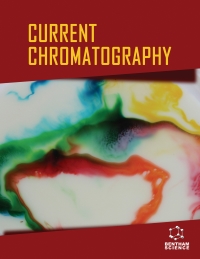- Home
- A-Z Publications
- Current Chromatography
- Previous Issues
- Volume 7, Issue 1, 2020
Current Chromatography - Volume 7, Issue 1, 2020
Volume 7, Issue 1, 2020
-
-
Strategy for Sustainable and Green Chromatographic Separation Science: Innovation, Technology and Application
More LessGreen separation science involves extraction, pre-concentration and chromatographic analysis aiming at minimizing environmental impact by reducing energy and reagent usage and reducing or eliminating waste generation. However, the enrichment of trace analytes and/or the analysis of complex matrices most frequently require several steps before analysis, such as extraction, pre-concentration, clean up and preparat Read More
-
-
-
Extraction and Quantification of Eugenol from Clove Buds Using HPLC
More LessBackground: Eugenol is the main constituent of clove essential oil. Past studies have found that clove oil has diverse uses in the pharmaceutical field due to its antioxidant, antibacterial and anesthetic properties. Objective: This work compares the performance of different extraction methods and factors and identifies the effect of the treatments on oil yields and eugenol content. Materials and Methods: Maceration, Hydro distill Read More
-
-
-
Total Carotenoids Content and Assessment of Carotene Profile by High-Performance Liquid Chromatography in Selected Vegetables of Bangladesh with Special Reference to Some Unconventional Varieties
More LessAuthors: Samia Sams, Mohammad K. Alam, Monira Ahsan and Sheikh Nazrul IslamBackground: Carotenoids are natural plant pigments and precursors of vitamin A, which provide a health benefit, protect against chronic degenerative diseases, and contribute to immune functions. Utilization and identification of foods with a high content of carotenoids received greater attention nowadays. Objective: The present study was aimed at evaluating total carotenoids content (TCC) and carotene compo Read More
-
-
-
Hydrophobic Deep Eutectic as a New Solvent for Liquid-Liquid Extraction and Its Potential Application in Ligandless Extraction of Cu (II)
More LessAuthors: Nur H. Sazali, Tham Wei Jie and Nurul Yani RahimBackground: The cost-effective and environmentally benign solvent of hydrophobic deep eutectic (DES) was prepared for the removal of Cu (II) from aqueous solution. Hydrophobic DES has been gaining increasing attention from researchers for the replacement of hazardous solvent consumption in liquid-liquid extraction (LLE). Objectives: To synthesize the hydrophobic DES and optimize the parameters for ligandless L Read More
-
-
-
Chromatographic Assessment of Polyphenolic Profile and Total Phenolic Content and Antioxidant Activity of Common Leafy Vegetables in Bangladesh
More LessBackground: Polyphenolic compounds are known to provide health benefits and protect against degenerative chronic diseases. Utilization and identification of foods with a high content of these compounds are gaining greater attention nowadays. Objective: The present study reports the total phenolic content (TPC), polyphenolic composition and antioxidant activity (DPPH, FRAP and TEAC) of 10 commonly consumed leafy Read More
-
-
-
Evaluation of Enantioselective Capillary Electrophoretic Approach for the Enantiomeric Separation of Abscisic Acid
More LessAuthors: Atiqah Binti Zaid, Udhayasurya N. Saravanan, Ng W. Ching, Bahruddin Saad and Yong Foo WongBackground: The application of enantioselective capillary electrophoresis approach for the assessment of the enantiomeric purity of chiral molecules is receiving increased attention. Abscisic acid is one of the chiral sesquiterpenic plant growth regulators that regulate various ecological and physiological roles in higher plants. Enantiomeric determination of ABA is of great concern because of the different biological activit Read More
-
-
-
Simultaneous Determination of Cationic and Anionic Surfactants in Environmental Water Samples by Ion-Pair Liquid Chromatography/Mass Spectrometry
More LessBackground: Cationic surfactants (CSs) such as quaternary ammonium compounds are used as fabric softeners, anti-bacterial agents, and human hair cosmetics. Accurate determination of CSs in environmental water samples is very difficult because of their very low concentration and strong adsorptivity to not only glassware but also to plasticware due to strong hydrophobic and electrostatic attractions. Linear alkylbenzene su Read More
-
Most Read This Month
Article
content/journals/cchg
Journal
10
5
false
en


